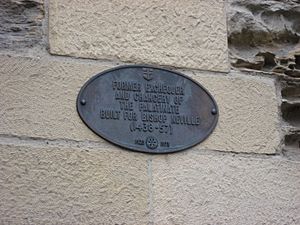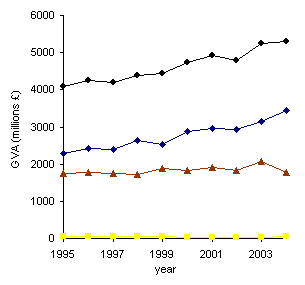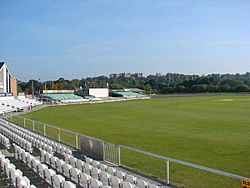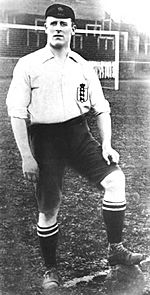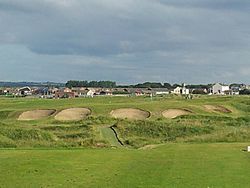County Palatine of Durham facts for kids
| Geography | |
| HQ | Durham |
| Chapman code | DUR |
| History | |
| Origin | Bishopric of Durham |
| Created | In antiquity |
| Succeeded by | County Durham (ceremonial from 1853) |
Quick facts for kids Politics |
|
|---|---|
| Governance | County Palatine |
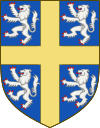 Arms of the Bishopric of Durham |
|
| Subdivisions | |
| Type | Wards |
 |
|
| Units | •Chester •Easington •Stockton •Darlington |
The County Palatine of Durham and Sadberge, commonly referred to as County Durham or simply Durham, is a historic county in Northern England. Until 1889, it was controlled by powers granted under the Bishopric of Durham. The county and Northumberland are also traditionally known together as Northumbria.
The boundaries stretch between the rivers Tyne and Tees. It borders four counties: Northumberland to the north, Yorkshire to the south as well as Westmorland and Cumberland to the west. Settlements with the most population in the county are Sunderland, Gateshead and Darlington.
During the Middle Ages, the county was an ecclesiastical centre due to the presence of St Cuthbert's shrine in Durham Cathedral. Durham Castle and Cathedral are UNESCO-designated World Heritage Sites. The county has a mixture of mining and farming heritage. Railway heritage is notable in the south of the county; Darlington, Shildon and Stockton.
Contents
Liberty of Durham
The territory was originally the Liberty of Durham under the control of the Bishop of Durham. The liberty was also known variously as the "Liberty of St Cuthbert's Land", "The lands of St. Cuthbert between Tyne and Tees" or "The Liberty of Haliwerfolc".
The bishops' special jurisdiction was based on claims that King Ecgfrith of Northumbria had granted a substantial territory to St Cuthbert on his election to the see of Lindisfarne in 684. In about 883, a cathedral housing the saint's remains was established at Chester-le-Street and Guthfrith, King of York granted the community of St Cuthbert the area between the Tyne and the Wear. In 995 the see was moved again to Durham.
Norman reorganisation
Following the Norman invasion, the administrative machinery of government was only slowly extended to northern England. In the twelfth century a shire or county of Northumberland was formed, and Durham was considered to be within its bounds. However the authority of the sheriff of Northumberland and his officials was disputed by the bishops. The crown still regarded Durham as falling within Northumberland until the late thirteenth century. Matters came to a head in 1293 when the bishop and his steward failed to attend proceedings of quo warranto held by the justices of Northumberland. The bishop's case was heard in Parliament, where he stated that Durham lay outside the bounds of any English shire and that "from time immemorial it had been widely known that the sheriff of Northumberland was not sheriff of Durham nor entered within that liberty as sheriff... nor made there proclamations or attachments". The arguments appear to have been accepted, as by the fourteenth century Durham was accepted as a liberty which received royal mandates direct. In effect it was a private shire, with the bishop appointing his own sheriff. The area eventually became known as the "County Palatine of Durham".
The term palatinus is applied to the bishop in 1293, and from the 13th century onwards the bishops frequently claimed the same rights in their lands as the king enjoyed in his kingdom.
St Cuthbert and the haliwerfolc
During the medieval period, St Cuthbert became politically important in defining the identity of the people living in the semi-autonomous region. Within this area the saint became a powerful symbol of the autonomy the region enjoyed. The inhabitants of the Palatinate became known as the haliwerfolc, which roughly translates as "people of the saint", and Cuthbert gained a reputation as being fiercely protective of his domain. For example, there is a story that at the Battle of Neville's Cross in 1346, the Prior of the Abbey at Durham received a vision of Cuthbert, ordering him to take the corporax cloth of the saint and raise it on a spear point near the battlefield as a banner. Doing this, the Prior and his monks found themselves protected "by the mediation of holy St Cuthbert and the presence of the said holy Relic." Whether the story of the vision is true or not, the banner of St Cuthbert was regularly carried in battle against the Scots until the Reformation, and it serves as a good example of how St Cuthbert was regarded as a protector of his people.
Sadberge
Sadberge was a liberty, sometimes referred to as a county, within Northumberland. In 1189 it was purchased for the see but continued with a separate sheriff, coroner and court of pleas. In the 14th century Sadberge was included in Stockton ward and was itself divided into two wards. The division into the four wards of, Chester-le-Street, Darlington, Easington and Stockton existed in the 13th century, each ward having its own coroner and a three-weekly court corresponding to the hundred court. The diocese was divided into the archdeaconries of Durham and Northumberland. The former is mentioned in 1072, and in 1291 included the deaneries of Chester-le-Street, Auckland, Lanchester and Darlington.
Early administration
At its historic extent, Durham included a main body covering the Catchment of the Pennines in the west, the River Tees in the south, the North Sea in the east and the Rivers Tyne and Derwent in the north. The county had a number of exclaves: Bedlingtonshire, Islandshire and Norhamshire within Northumberland, and Craikshire within the North Riding of Yorkshire. In 1831 the county covered an area of 679,530 acres (2,750.0 km2) and had a population of 253,910. The historic boundaries were used for parliamentary purposes until 1832, and for judicial and local government purposes until the coming into force of the Counties (Detached Parts) Act 1844, which merged most remaining exclaves with their surrounding county.
Until the 15th century the most important administrative officer in the palatinate was the steward. Other officers were the sheriff, the coroners, the chamberlain and the chancellor. The palatine exchequer was organised in the 12th century. The palatine assembly represented the whole county, and dealt chiefly with fiscal questions. The bishop's council, consisting of the clergy, the sheriff and the barons, regulated the judicial affairs, and later produced the Chancery and the courts of Admiralty and Marshalsea.
Durham city was captured by a Norman army in 1069. There was a rebellion against the new Norman earl Robert de Comines, who was killed. However, County Durham largely missed the Harrying of the North that was designed to subjugate such rebellions. The best remains of the Norman period are to be found in Durham Cathedral and in the castle, also in some few parish churches, as at Pittington and Norton in Stockton. Of the Early English period are the eastern portion of the cathedral, the churches of Darlington, Hartlepool, and St Andrew, Auckland, Sedgefield, and portions of a few other churches.
The prior of Durham ranked first among the bishop's barons. He had his own court, and almost exclusive jurisdiction over his men. There were ten palatinate barons in the 12th century, the most important being the Hyltons of Hylton Castle, the Bulmers of Brancepeth, the Conyers of Sockburne, the Hansards of Evenwood, and the Lumleys of Lumley Castle. The Nevilles owned large estates in the county. Raby Castle, their principal seat, was rebuilt by John Neville, 3rd Baron Neville de Raby in 1377.
Edward I's quo warranto proceedings of 1293 showed twelve lords enjoying more or less extensive franchises under the bishop. The repeated efforts of the Crown to check the powers of the palatinate bishops culminated in 1536 in the Act of Resumption, which deprived the bishop of the power to pardon offences against the law or to appoint judicial officers. Moreover, indictments and legal processes were in future to run in the name of the king, and offences to be described as against the peace of the king, rather than that of the bishop. In 1596 restrictions were imposed on the powers of the chancery, and in 1646 the palatinate was formally abolished. It was revived, however, after the Restoration, and continued with much the same power until 5 July 1836, when the Durham (County Palatine) Act 1836 provided that the palatine jurisdiction should in future be vested in the Crown. Doubts about the construction of this Act led to the enactment of the Durham County Palatine Act 1858.
During the Wars of the Roses, Henry VI passed through Durham. On the outbreak of the Great Rebellion Durham inclined to support the cause of Parliament, and in 1640 the high sheriff of the palatinate guaranteed to supply the Scottish army with provisions during their stay in the county. In 1642 the Earl of Newcastle formed the western counties into an association for the King's service, but in 1644 the palatinate was again overrun by the Scottish army, and after the Battle of Marston Moor fell entirely into the hands of Parliament.
In 1614 a bill was introduced in Parliament for securing representation to the county and city of Durham and the borough of Barnard Castle. The movement was strongly opposed by the bishop, as an infringement of his palatinate rights, and the county was first summoned to return members to Parliament in 1654. After the Restoration the county and city returned two members each. By the Reform Act of 1832 the county returned two members for two divisions, and the boroughs of Gateshead, South Shields and Sunderland acquired representation. The boroughs of Darlington, Stockton and Hartlepool returned one member each from 1868 until the Redistribution Act of 1885.
The Durham County Palatine Acts 1836 to 1889
The Durham County Palatine Acts 1836 to 1889 was the collective title of the Durham County Palatine Act 1836, the Durham County Palatine Act 1858, the Durham Chancery Act 1869 and the Palatine Court of Durham Act 1889.
Economy
Economic history
County Durham has long been associated with coal mining, from medieval times up to the late 20th century. The Durham Coalfield covered a large area of the county, from Bishop Auckland, to Consett, to the River Tyne and below the North Sea, thereby providing a significant expanse of territory from which this rich mineral resource could be extracted.
King Stephen possessed a mine in Durham, which he granted to Bishop Pudsey, and in the same century colliers are mentioned at Coundon, Bishopwearmouth and Sedgefield. Cockfield Fell was one of the earliest Landsale collieries in Durham. Richard II granted to the inhabitants of Durham licence to export the produce of the mines, the majority being transported from the Port of Sunderland complex which was constructed in the 1850s.
Among other early industries, lead-mining was carried on in the western part of the county, and mustard was extensively cultivated. Gateshead had a considerable tanning trade and shipbuilding was undertaken at Sunderland, which became the largest shipbuilding town in the world – constructing a third of Britain's tonnage.
The county's modern-era economic history was facilitated significantly by the growth of the mining industry during the nineteenth century. At the industry's height, in the early 20th century, over 170,000 coal miners were employed, and they mined 58,700,000 tons of coal in 1913 alone. As a result, a large number of colliery villages were built throughout the county as the industrial revolution gathered pace.
The railway industry was also a major employer during the industrial revolution, with railways being built throughout the county, such as The Tanfield Railway, The Clarence Railway and The Stockton and Darlington Railway. The growth of this industry occurred alongside the coal industry, as the railways provided a fast, efficient means to move coal from the mines to the ports and provided the fuel for the locomotives. The great railway pioneers Timothy Hackworth, Edward Pease, George Stephenson and Robert Stephenson were all actively involved with developing the railways in tandem with County Durham's coal mining industry. Shildon and Darlington became thriving 'railway towns' and experienced significant growths in population and prosperity; before the railways, just over 100 people lived in Shildon but, by the 1890s, the town was home to around 8,000 people, with Shildon Shops employing almost 3000 people at its height.
However, by the 1930s, the coal mining industry began to diminish and, by the mid-twentieth century, the pits were closing at an increasing rate. In 1951, the Durham County Development Plan highlighted a number of colliery villages, such as Blackhouse, as 'Category D' settlements, in which future development would be prohibited, property would be acquired and demolished, and the population moved to new housing, such as that being built in Newton Aycliffe. Likewise, the railway industry also began to decline, and was significantly brought to a fraction of its former self by the Beeching cuts in the 1960s. Darlington Works closed in 1966 and Shildon Shops followed suit in 1984. The county's last deep mines, at Easington, Vane Tempest, Wearmouth and Westoe, closed in 1993.
Post markings
Postal Rates from 1801 were charged depending on the distance from London. Durham was allocated the code 263 the approximate mileage from London. From about 1811, a datestamp appeared on letters showing the date the letter was posted. In 1844 a new system was introduced and Durham was allocated the code 267. This system was replaced in 1840 when the first postage stamps were introduced.
Demography
Employment
The proportion of the population working in agriculture fell from around 6% in 1851 to 1% in 1951; currently less than 1% of the population work in agriculture. There were 15,202 people employed in coal mining in 1841, rising to a peak of 157,837 in 1921.
Exclaves
Throughout the 1800s exclaves of the historic county were given to surrounding shires and lands they were closer associated with:
- Yorkshire (East Riding): Howdenshire
- Yorkshire (North Riding): Allertonshire
- Northumberland: Bedlingtonshire, Islandshire (included Berwick-upon-Tweed)
Sport
Cricket
Durham Cricket represent the historic county in the domestic first class cricket County Championship; with 3 championship titles. The two amateur ECB Premier Leagues in the county are North East Premier League and NYSD Cricket League.
Durham County Cricket Club formed in 1882. After years of success in the Minor Counties Championship, Durham was accepted into the senior counties championship in 1992. The Riverside cricket ground regularly hosts international cricket; its first "Ashes" Test Match between England and Australia was in August 2013. With 320 runs and 15 wickets on the last day of the match, the venue provided "the most high-octane day of a thrilling Test match", and England took an unassailable 3-0 lead against the Australians in the five-match Ashes Test series.
Association football
Male league football clubs founded in County Durham include:
|
|
Below the Northern Premier League, is the Northern Football League. At county-level, the area is governed by the Durham County Football Association. The next step down, after the NFL, play in the Northern Football Alliance or the North Riding Football League. The system is then multiple Sunday or Saturday leagues. Female league football clubs in the county include; Durham, Middlesbrough (play in Billingham) and Sunderland.
Heritage
A precursor of modern football is the Sedgefield Ball Game which has been a long standing tradition. Sunderland Association Football Club was formed in 1879. Darlington formed in 1861 (re-formed 1883 and in 2012) and West Hartlepool of 1881 became Hartlepool United in 1908. Sunderland was rivalled by a break-away team called Sunderland Albion, which were lost before the 20th century began. Sunderland won the league championship three times in the 1890s.
Today top quality professional football remains in County Durham. In 2017–18 season, Sunderland were in the Football League Championship, Hartlepool and Gateshead FC compete in the National League. The Stadium of Light in Sunderland is a first class football venue is used for some international games at every levels.
Amateur and semi-professional football clubs like Bishop Auckland has had success and public attention through its Football Association Cup runs, but the most famous achievement was by West Auckland Town FC in 1910: they were invited to take part in a competition in Italy to compete for what was then labelled the soccer World Cup. West Auckland won the competition against some of Europe's biggest sides; they defeated the mighty Juventus 2–0 in the final. They even successfully defended the title the following year. The first World Cup trophy played for in these tournaments, Sir Thomas Lipton Trophy, has an interesting history of its own. In January 1994 the trophy, which was being held in West Auckland Working Men's Club, was stolen and never recovered. An exact replica of the original trophy was commissioned and is now held by West Auckland FC. The story of West Auckland's success was made into a film called "A Captain's Tale", starring actor Dennis Waterman as club captain Jones.
Players from some of the counties minor league teams have gone on to influence football on the world stage. Jack Greenwell (John Richard Greenwell), an ex-coal miner who played non-league football for Crook Town A.F.C. from 1901 to 1912, went to Spain and played 88 games for Barcelona before becoming their manager in 1917. Greenwell's achievements at Barcelona include winning five Catalan championships and two Copas del Rey. He also managed Espanyol, Mallorca and Valencia. On the outbreak of the Spanish Civil War, he moved to South America to manage the Peruvian and Colombian national teams; he died in 1942 in Bogotá.
Notable footballers
There are many notable footballers from the county of Durham . Sunderland's Alf Common became the world's first £1,000 player when he was signed by Middlesbrough in 1905. Other pre Second World War and immediate post war greats were Charlie Buchan, who created and edited the iconic magazine "Football Monthly", George Camsell, Hughie Gallacher, Raich Carter, Bobby Gurney all of whom are described in a famous book by the "Clown Prince of Football" Len Shackleton. Shackleton's book shot to immediate fame and caused a storm when first published because chapter 9, named "The Average Director's Knowledge of Football", was produced as a blank page. After the Second World War notable footballers included Joe Harvey (Crook manager from 1954–1955), Brian Clough, and Sunderland goalkeeper Jim Montgomery, who helped the then Second Division club Sunderland beat Leeds United to win the 1973 FA Cup Final.
Rugby Union
Rugby union teams based in Durham County:
|
|
The Durham County RFU is affiliated with the Durham/Northumberland divisions.
Horse racing
Sedgefield Racecourse is the only operating course in the county. Early races were mentioned in 1613 at Woodham near Aycliffe. Georgian races were held at places like Barnard Castle, Bishop Auckland, Blaydon, Chester-le-Street, Darlington, Durham, Gateshead, Hebburn, Heighington, Lanchester, Ryton, Sedgefield, Shincliffe, South Shields, Stockton, Sunderland, Tanfield, Whickham and Witton Gilbert. A 1740 Act banned smaller meetings but some meetings like Durham survived into the late 19th or early 20th centuries. Horse racing is still takes place at Sedgefield Racecourse.
Golf
There is one old links course in the county at Seaton Carew, which opened in 1874. The Seaton Carew Golf Club was the only course in the whole of Durham and Yorkshire, it was therefore originally called the Durham and Yorkshire Golf Club, a reference to this today remains in the Club's badge. Seaton Carew is the 10th oldest Golf Club in England. The Club was set up by a newly qualified surgeon from Edinburgh, who played at Musselburgh, when he realised there was nowhere for him to continue to practice his passion for the game. This was Dr. Duncan McCuaig, after qualifying at University of Edinburgh. His memory can be recalled when one plays the third hole, a challenging par 3, named "The Doctor". Over the years some of the finest golfers in the country have played the links at Seaton Carew, including the legendary "Great Triumvirate" of Golf Harry Vardon, John Henry "J H" Taylor and James Braid and several other Open Champions.
Dr Alister MacKenzie, the designer of Augusta National Golf Club in Augusta, Georgia, home of The Masters, and the Cypress Point golf course in California, lengthened the Seaton Carew Course in 1925 to 6,500 yards and designed new holes eastwards including the planting of over 2,000 buckthorn bushes. In 1937, Walter Hagen played an exhibition match at Seaton Carew during a tour of Europe and commented "It is a splendid course, the links are well groomed. It is not an easy course and provides a good test of golf. It is one I would like to play quite often". This Club by varying the playing sequence of the 22 holes can create 5 different course layouts. In 2014, "flyovers" of all 5 Seaton Carew Golf Course layouts were created with commentaries by TV commentator Peter Alliss. Alliss comments: "The tenth oldest in England and a true championship links to challenge all levels of players."
Seaton Carew Golf Club is regular host to top amateur golf competitions. Golf England's Brabazon Trophy was held at this Club in 1985 and the winner, Peter Baker, went on to Ryder Cup and European Tour success after sharing this amateur title with the North East's Roger Roper (Roper turned professional at the age of 50 in 2007 to compete on the Seniors Professional Tour). In June 2014, The Brabazon Trophy tournament returned to Seaton Carew and in line with the illustrious outcomes for past winners on this course a bright future is predicted for the winner Ben Stow from Wiltshire. Stow equalled the course record on the final day with a "birdie" on the final hole to win the Barabzon Trophy by one shot.
They is multiple inland golf courses in the county, those courses created in the late 20th and early 21st centuries are Brancepeth Golf Club, Wynyard, Rockciffe Hall, Slalely Hall and Close House have an international reputation and regularly hold professional events such as the Seve Trophy and the Seniors Tour. Graeme Storm from Hartlepool has won events on the European Tour.
Athletics
Athletics in the county has had olympic and international success of athletes Brendan Foster in the 1970s and Steve Cram in the 1980s. Both won international medals and broke world records in middle and long distance running. Brendan Foster established the annual Great North Run, one of the best known half marathons in which thousands of participants run from Newcastle to South Shields. Brendan Foster, a former school teacher in this region, is also recognised as the driving force behind the creation of the Gateshead International Athletics Stadium which now regularly hosts International Athletics meets and other sporting events.
In 2013 the 33rd Great North Run had 56,000 participants most of whom were raising money for charity. The elite races had Olympic gold medalists and world champion long distance runners participateing including in the men's race, Mo Farah, Kenenisa Bekele and a regular supporter of the event Haile Gebrselassie. Ethiopian Bekele won the men's event just ahead of Farah. Kenya's Priscah Jeptoo came first the women's race and multi Olympic gold medalist David Weir won the wheelchair event. The 2014 Great North Run had its millionth finisher – becoming the first International Athletics Association Event (IAAF) event in the world to reach such a milestone. The 2014 Great North Run also saw Mo Farah win the men's race in an hour. The millionth finisher was a Tracey Cramond of Darlington. 51 year old Tracey ran the race to raise funds for Butterwick Hospice.
Images for kids
-
Durham Cathedral is a UNESCO World Heritage Site. Construction began in 1093.
-
The Angel of the North in Gateshead
-
The Transporter Bridge between Port Clarence and Middlesbrough, Yorkshire
-
The Bowes Museum in Barnard Castle
-
The Penshaw Monument.
-
Yarm Viaduct between Eaglescliffe and Yarm, Yorkshire


